Our Products
More Information
Email us: [email protected] Need Help? Call us on: 0203 846 0345
Free, Fast Delivery Over £750
10 Year Guarantee
Price Match Promise
3500+ Doors Sold A Week
Expert Advice
Blog » 11 Houseplants With “Superpowers” That Are Perfect For Beginners
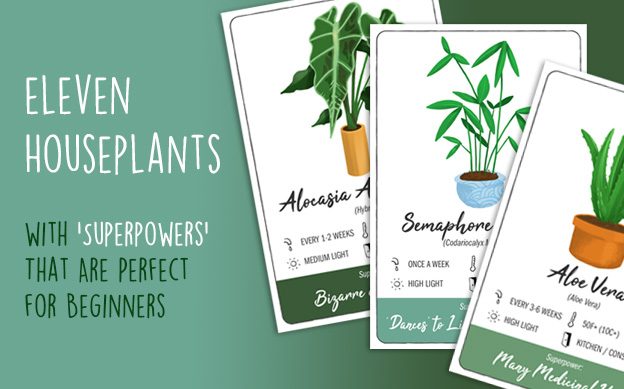
If you’re just about to embark on your first houseplant buying expedition, there’s a good chance you’re not really sure which ones you’d like to buy. Do you go for something colourful and delicate? Or what about something robust and imposing?
Whatever you choose, it needs to be looked after. But some houseplants are way more high-maintenance than others. There’s nothing worse (there probably is) when you’re a new plant parent, than coming home to find your beautiful new addition all shrivelled and brown. Whether that’s because it didn’t quite like the fact you sat it by a draughty door, or you forgot to water it for a day or two…
So what’s the answer? Treat yourself to some super easy-going houseplants, of course! Houseplants that are really easy to care for don’t need to be boring either. There are loads of funky houseplants out there to choose from, but knowing which is right for you can be tricky, especially when you’re not quite sure what it is you’re doing.
So, we’ve put together a list of our favourite houseplants for beginners… they all have “superpowers”! All of the plants we’ve chosen are low-maintenance, stylish and above all, they’ll totally dazzle you with their brilliance, too!
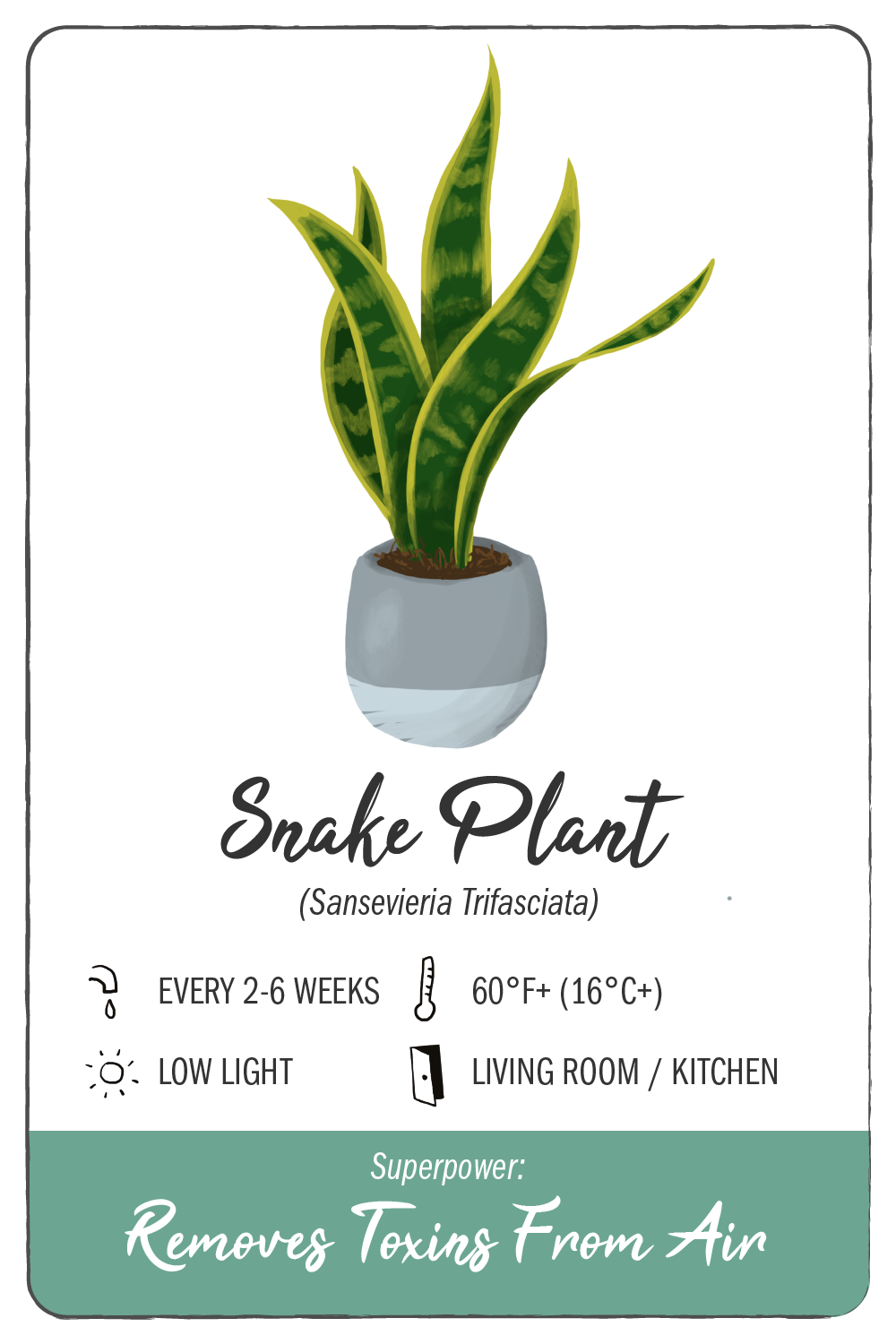
Possibly one of the easiest houseplants to take care of, no list is complete without the Snake Plant – or Mother-in-Laws Tongue depending on where you’re from. Native to tropical West Africa, the Snake Plant is hardy and and low-maintenance and as one of only a few plants that processes carbon dioxide using the crassulacean acid metabolism process, it can go long periods of time without water, so only needs to be watered every month or so… perfect for anyone that spends a lot of time away from home. It’s also happy to live in low light conditions, meaning you don’t have to worry about where you put it.
One of the main benefits of owning a Snake Plant (other than its obvious style) is its ability to remove toxins from the air. The NASA Clean Air Study noted that the Snake Plant is capable of removing 4 out of the 5 main toxins involved in the effects of “sick building syndrome”, including Formaldehyde and Benzene… There are only 5 other plants that have been found to remove so many!
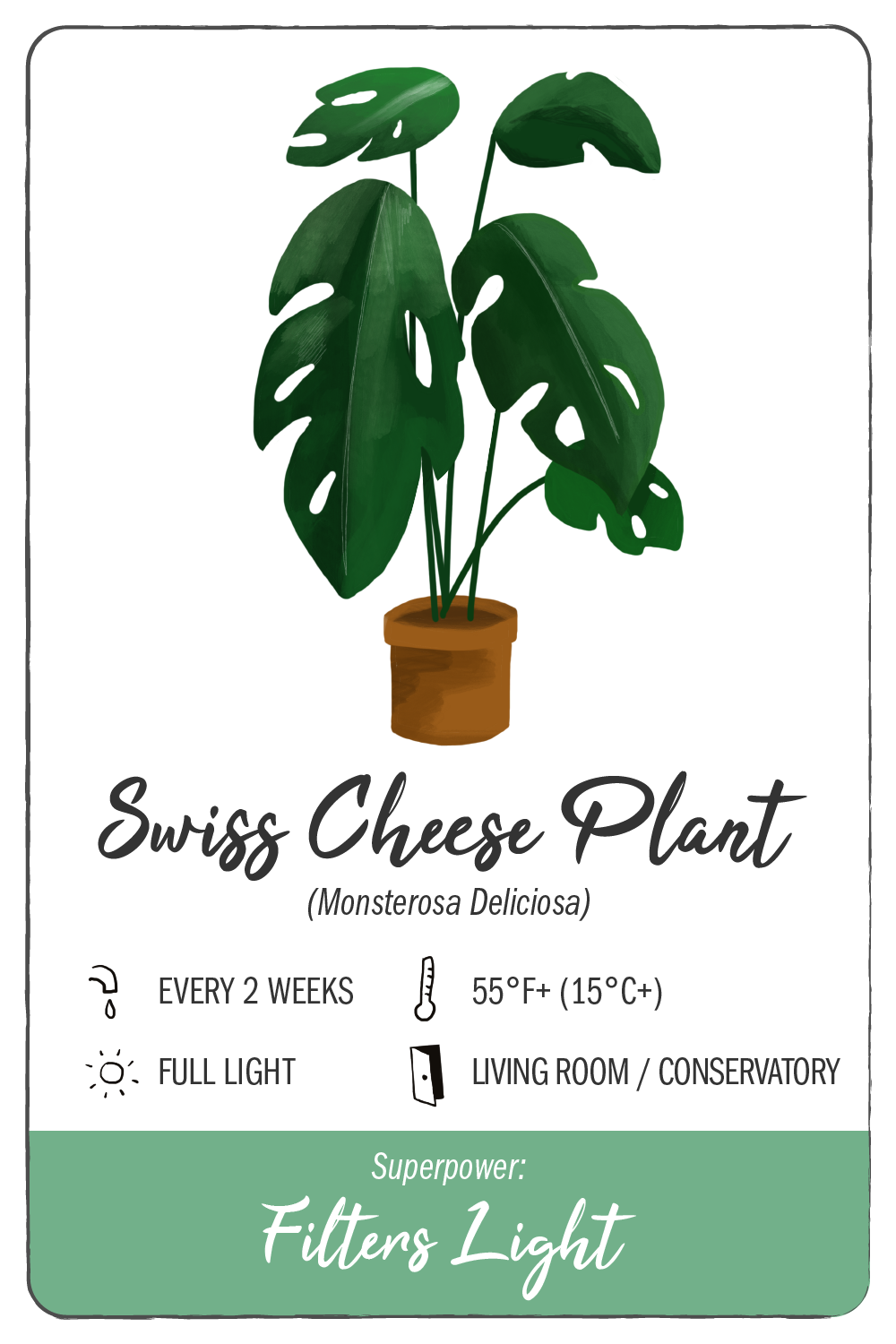
If you want a large plant that’s going to be the centre of attention, then the Swiss Cheese Plant is the one for you. Also known as the Mexican Breadfruit or the Hurricane Plant, the Swiss Cheese Plant is so named due to the large leaves that develop holes as they grow… much like the cheese! This is a trait unique to the Monstera species and these unusual leaves are perfect for those that wish to use the natural light as a feature in their home. They’re also very handy should you wish to create some shade, making them the perfect addition to any large living space or conservatory.
Thought the Swiss Cheese Plant is perfectly happy in low light conditions, it’s best suited to bright, indirect sunlight which will help it to flourish – perfect for sitting by your patio doors. You might think that such a large plant would need watering constantly too, but no, once every couple of weeks should be just fine.
The Swiss Cheese was also voted Office Plant of the Year 2018 by Plants At Work… in case you needed another reason to buy one!
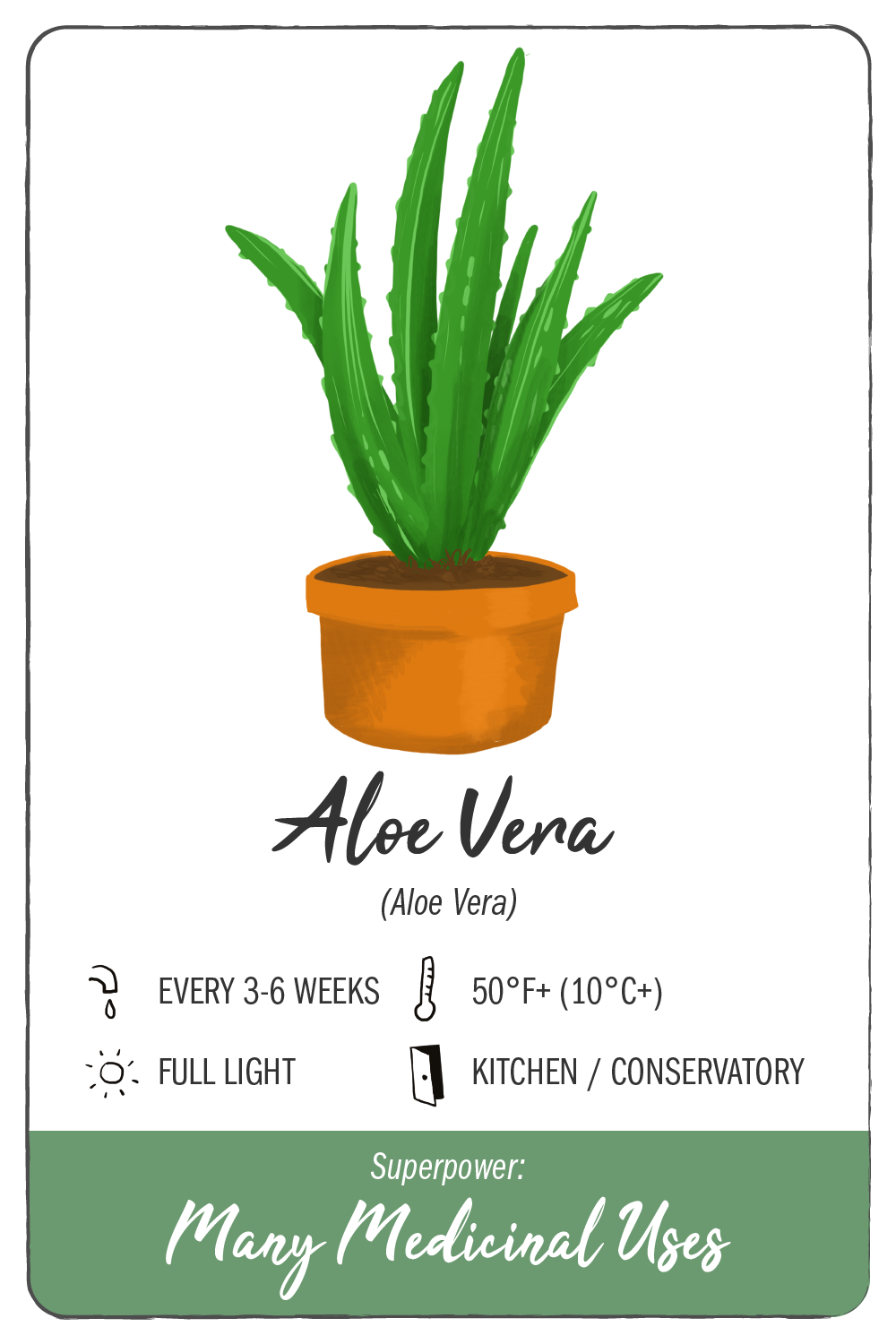
It’s likely you’ve used a well-being product that contains Aloe Vera at some point. Whether that’s a moisturiser, toilet paper or even a drink, it seems there’s nothing Aloe Vera can’t be added to as a health benefit. Often referred to as the First Aid Plant due to its many medicinal uses, as well as its excellent moisturising qualities, it’s said that the Aloe Vera plant can accelerate the healing of burns, lower blood sugar levels and even reduce dental plaque with its antioxidant and antibacterial properties.
But what about style factor? Well, we think the Aloe Vera is one of the most stylish houseplants out there… and it’s one of the most easy-going too. All this spiky little critter asks for in return is a sunny spot away from cold draughts and a drink every month. Going “dormant” during the winter months they require even less, so a watering every 6 weeks should be all that’s needed. As a native of the Arabian deserts, they do prefer a more sandy soil… but beyond that, they’re definitely a houseplant that gives more than they take!
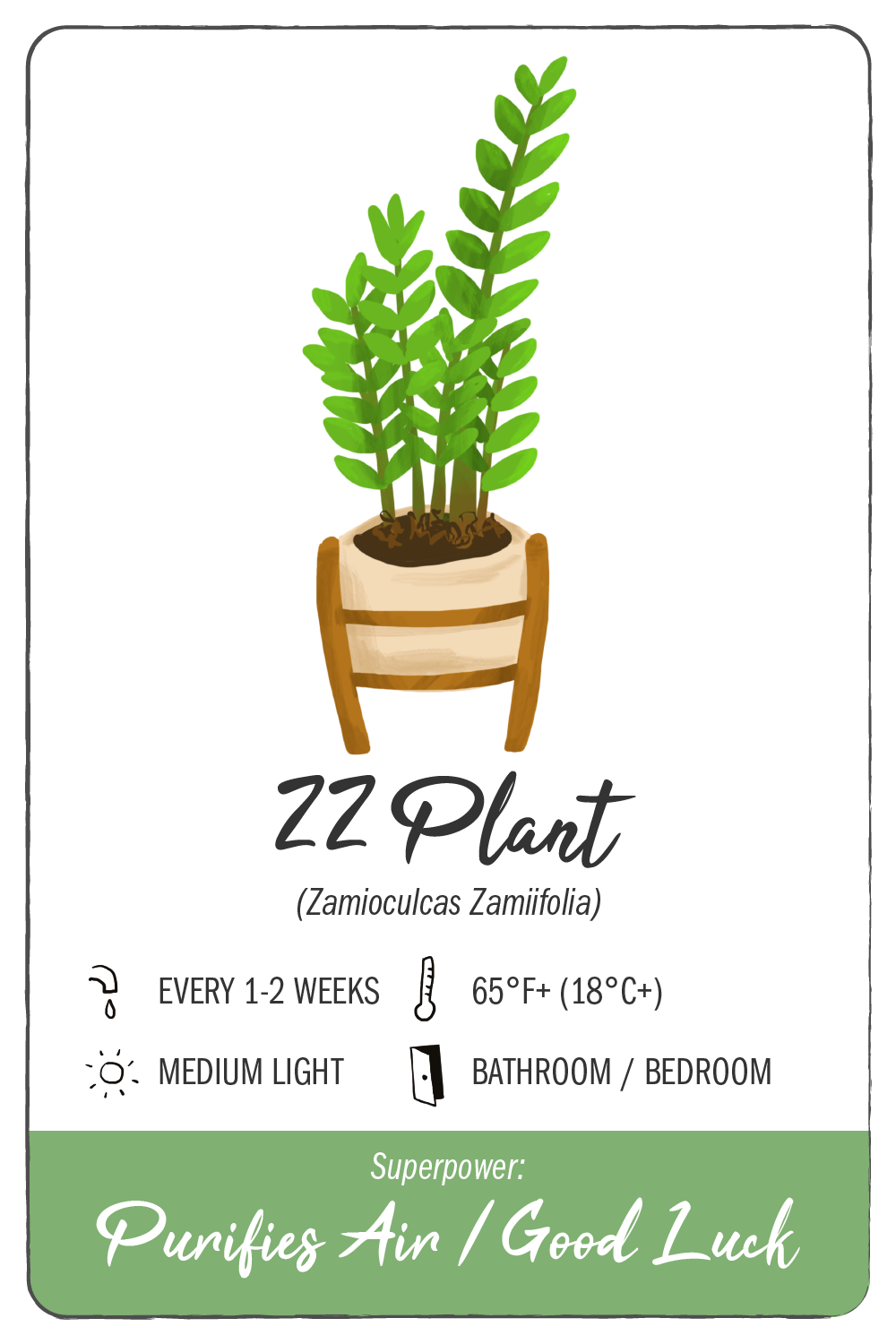
If you want foliage without the hassle of constant pruning, then the ZZ Plant should be at the top of your houseplant buying list. Super easy to care for and probably one of the toughest houseplants out there, it’s pretty difficult to get it wrong with a ZZ Plant (or Zanzibar Gem as it’s affectionately known).
With an abundance of waxy, almost patent leaves, the ZZ Plant is slow growing and only needs to be watered every couple of weeks – making it a dream addition to the family for any new plant parent. It’s also happy in both low and bright light conditions, so there really isn’t anywhere it can’t be positioned in your house. As a tropical perennial native to Eastern Africa, it’s quite adept at coping with both slightly humid and dryer conditions, making it the perfect houseplant to jazz up your bathroom or your bedroom.
As well as being super easy going, the ZZ Plant also has air purifying qualities and has been found to remove such toxins as Toluene and Xylene from the atmosphere. As well as having health benefits, according to Feng Shui theory, the ZZ Plant is said to bring good luck and wealth and as a result, it’s often referred to as the Fortune Tree.
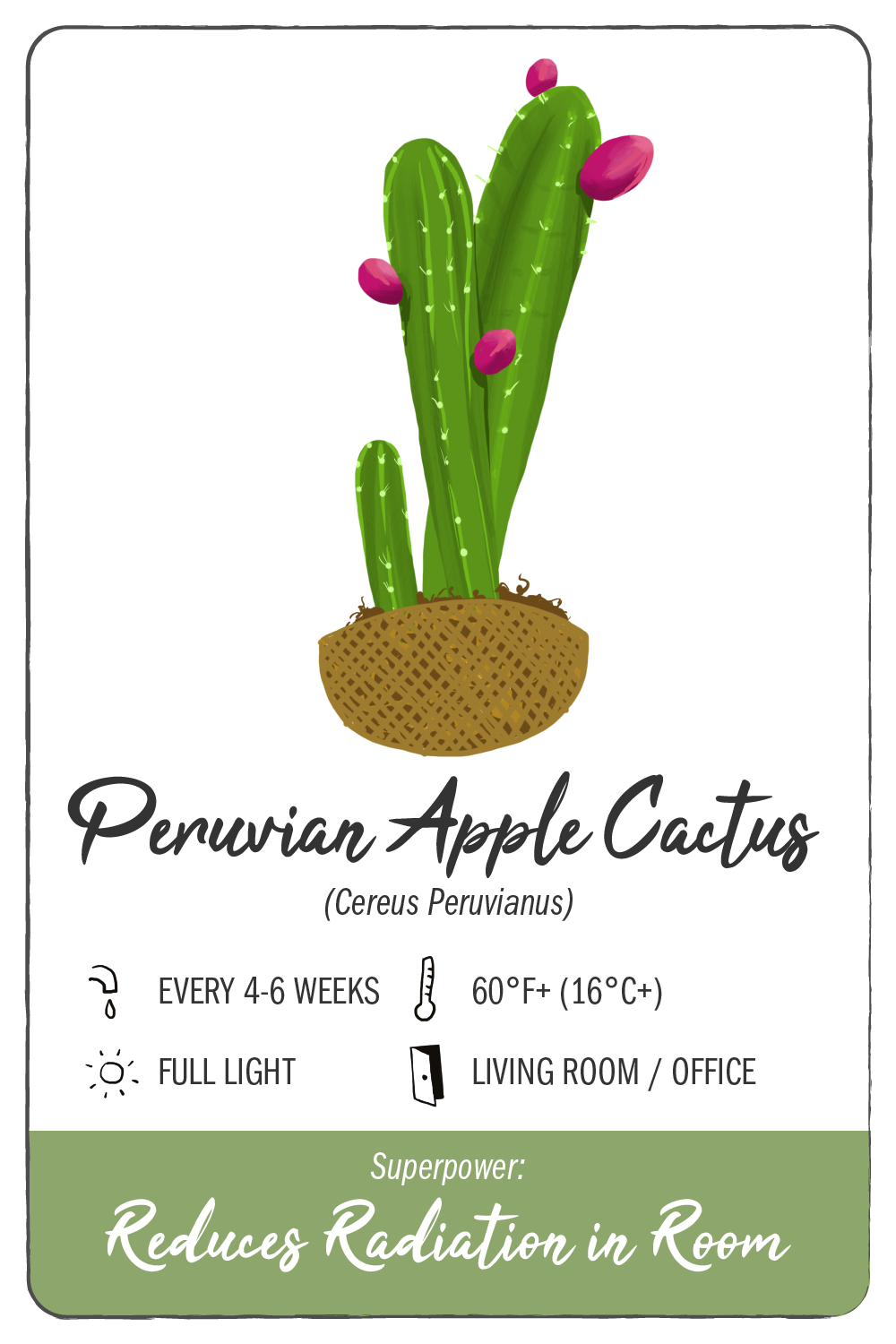
Is any home or office complete without a cactus? We say no, so why not go for one that not only bears fruit but can help reduce radiation too?
A weird one, right? But it’s apparently true… putting a Peruvian Apple Cactus in a room that has a lot of tech (such as computers, phones and TVs) can help reduce the amount of radiation present by intercepting and absorbing the electromagnetic waves. In an age where we’re overwhelmed by technology, this houseplant is definitely one we all could do with owning!
Given its awesome superpowers, the Peruvian Apple Cactus is surprisingly simple to look after. Native to the northern parts of South America, it appreciates bright light and good drainage, and it only needs to be watered every 4-6 weeks, perfect for anyone that wants a funky looking houseplant with virtually no hassle. And if you’re lucky enough, over time it may even produce some fruit for you!

Possibly the most kitsch houseplant on our list, the Bromeliad Pineapple is a definite showstopper! Native to South America, this ornamental houseplant (don’t eat it!) is certain to get attention and can really amplify the look you’re trying to achieve with your decor.
But that’s not all it’s good for! Oh no. One of the key features of the Bromeliad Pineapple plant, is its unusual ability to release oxygen at night, but not only that, the slight scent that is also released is actually an anti-inflammatory enzyme called Bromylaine that helps to expand the airways and ultimately reduces snoring.
Despite its seemingly complex array of qualities, the Bromeliad Pineapple is really easy to keep. Placing it in a sunny spot by a window will see it flourish and it only needs to be watered once a month or so, too. If you really want to see it bloom, give it a light misting in between watering and if you have any apples that are well past their best, add them to the soil as Bromeliads LOVE the ethylene gas they release.
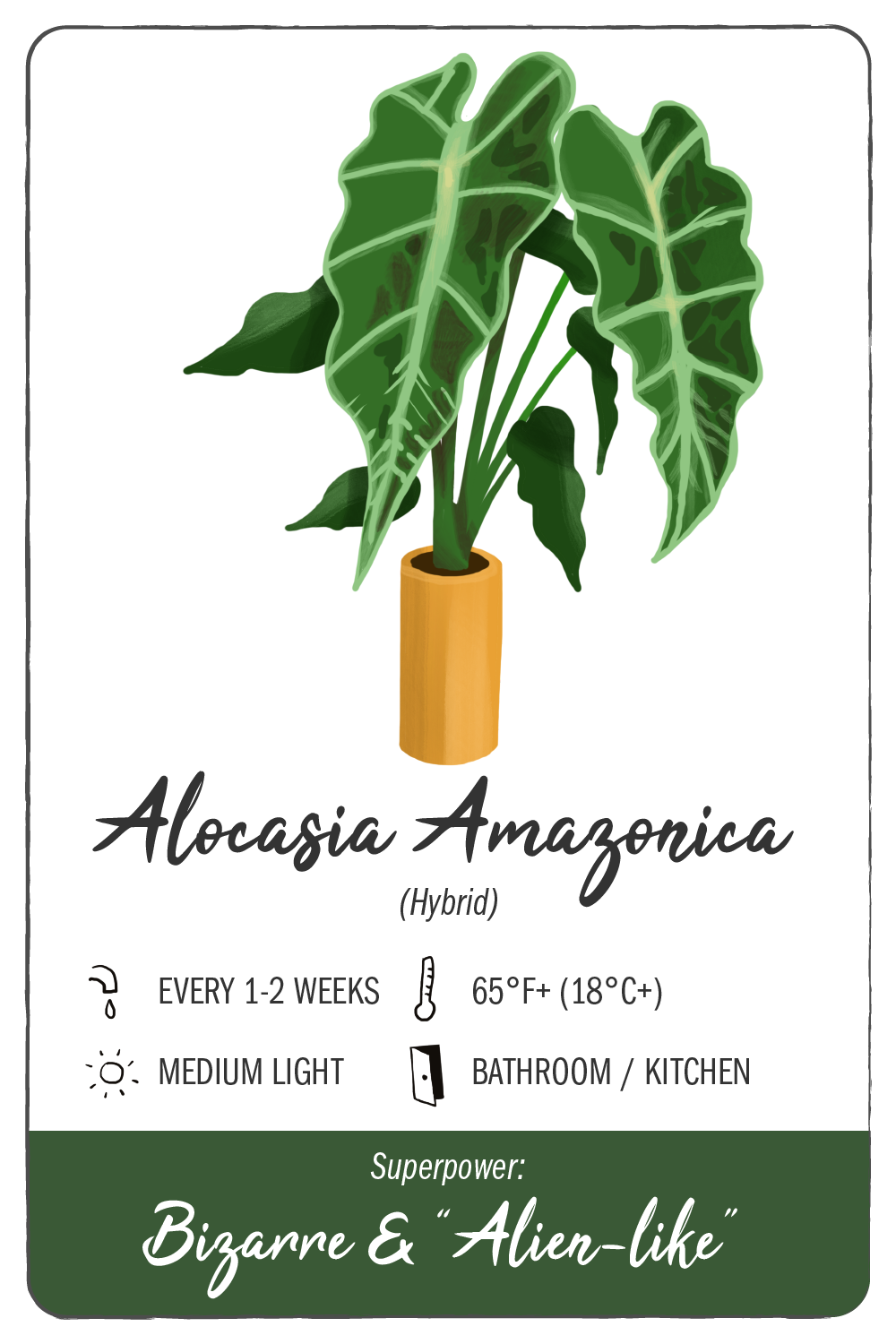
If you fancy adding a touch of futuristic whimsy to your living space, then the Alocasia Amazonica is the perfect addition. Due to the unique shape and texture of the leaves, it’s commonly known as Elephant Ear or African Mask Plant but this crazy looking houseplant is actually a hybrid from Southern Asia, despite its many names suggesting otherwise.
Though it’s not impossible for the Alocasia to flower, it’s all about the foliage. The striking and dramatic two-tone leaves with pronounced silver veins means this fabulous houseplant can really make a statement. They grow quickly too, so can soon become a big part of the family.
While the Alocasia Amazonia can live happily in low light, they do appreciate some sunlight, so place them in a spot that has partial shade and they’ll be just right. As a plant that’s used to a tropical environment, a warmer, slightly humid environment suits them best, making them the perfect houseplant for the bathroom or kitchen. Due to their preference for a humid environment, they don’t need much watering either, just once every couple of weeks should be fine.
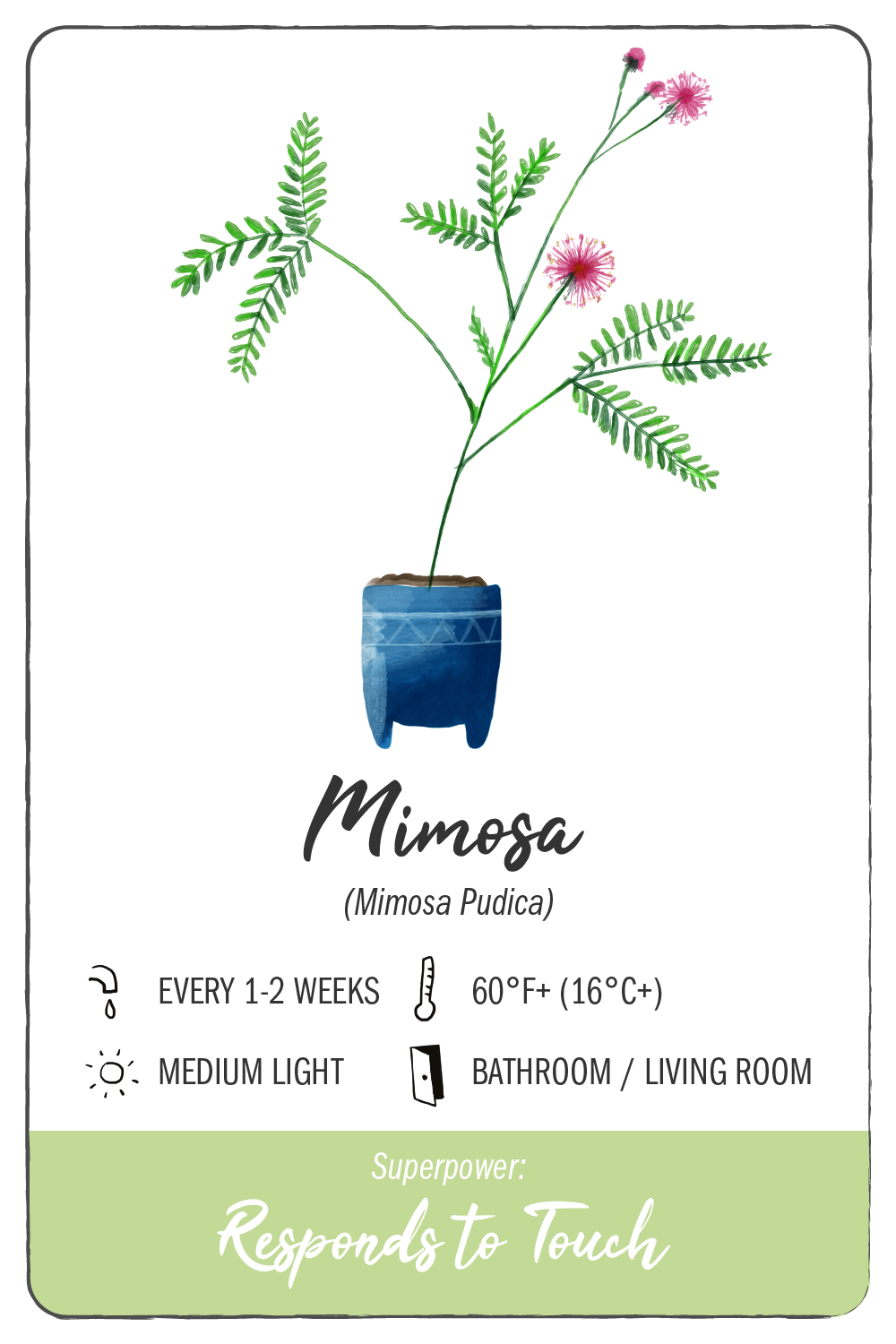
Interactive plants are the best! We think so anyway, and the Mimosa plant is a beautiful example. Over the years, it’s earned itself numerous nicknames and is commonly known as the Shameplant, Touch-me-not and Sensitive Plant. Another South American native, the Mimosa seemingly has an affliction… it doesn’t like to be touched! Or that’s how it appears…
Like a small number of other plant species, the Mimosa is known for its rapid plant movement (or nyctinastic movement if you want to get scientific), which means the leaves will close in darkness and reopen in light, effectively going to “sleep”. What makes the Mimosa unique is that it has a similar response to touch and vibrations too (this is regarded as seismonastic movement for those that are interested), and it became the focus of many studies because of it.
Probably one of the most fun and intriguing houseplants to own, there will never be a dull moment with a Mimosa in your life and you’ll find it hard not to get attached to it! And it’s really easy to care for too. It’s not a fan of direct sunlight but it does like a slightly humid spot, so it’s another one that’s perfect for your bathroom. Though, if you’d prefer it in other parts of the house, regular misting will definitely make it happy. Water it every other week and you’ll have a friend for life (sort of).
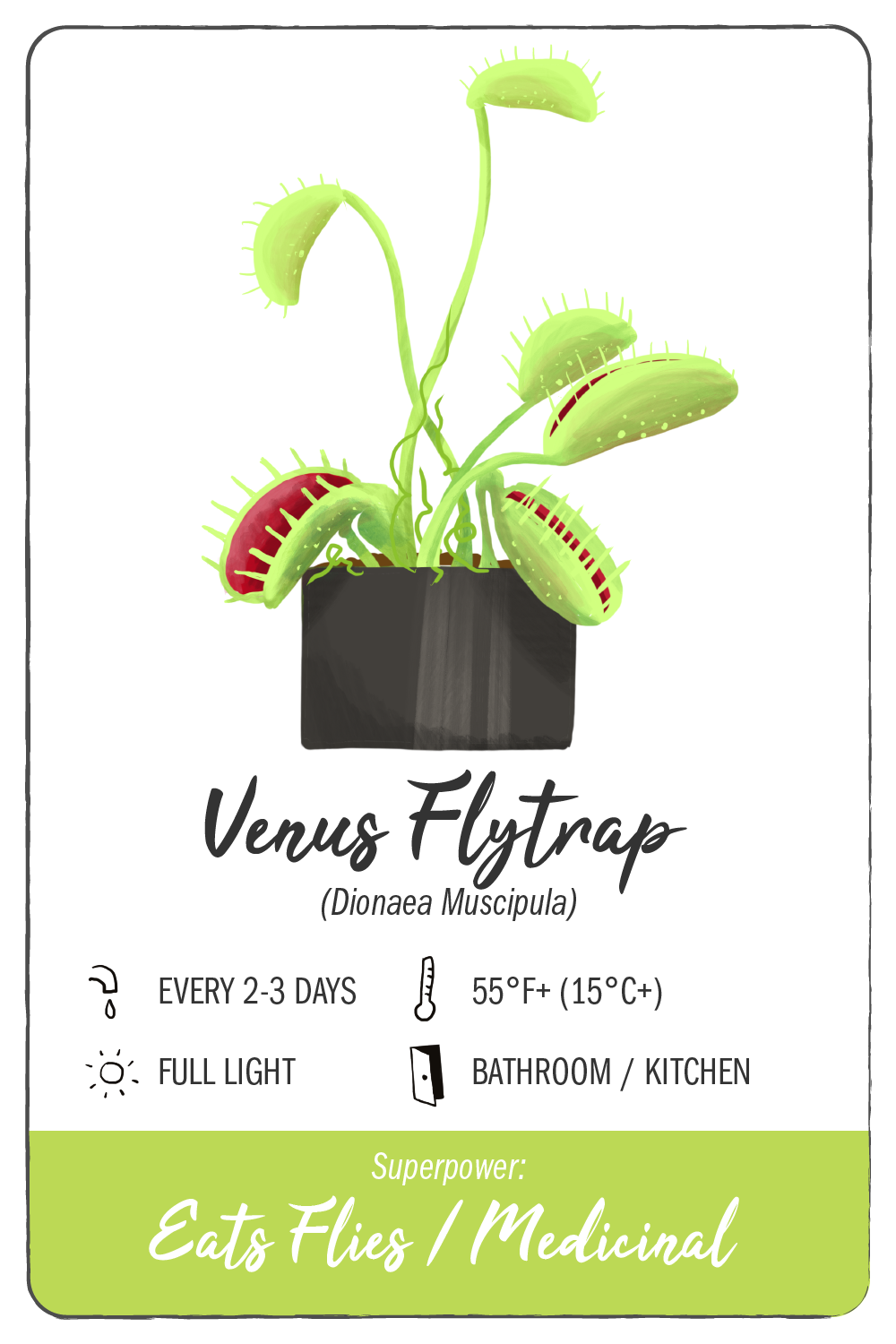
If you’ve ever seen The Little Shop of Horrors then you’ll no doubt LOVE the Venus Flytrap. While Audrey II wasn’t strictly a Venus Flytrap, you can see where the inspiration came from, and the cult hit certainly gave carnivorous plants the notoriety they deserve!
A native of the subtropical wetlands of North America, the Venus Flytrap doesn’t just catch flies as the name might suggest. In fact, the Venus Flytrap’s diet is estimated to be 30% ants, 30% spiders, 10% beetles and 10% grasshoppers, with fewer than 5% flying insects. So, not only are they ridiculously cool, but they’re great for reducing the amount of bugs in your house too.
If you’re curious about how the Venus Flytrap “eats” its prey, here’s the science… when its prey is unable to escape, it will continue to stimulate the inner surface of the lobes (leaves), and this causes a further response that forces the edges of the lobes together, eventually sealing the trap and forming a “stomach”. Release of the digestive enzymes is controlled by the hormone jasmonic acid, which is the same hormone that triggers the release of toxins as a defense mechanism in non-carnivorous plants. Once the digestive glands in the leaf lobes have been activated, digestion is then catalysed by hydrolase enzymes that are secreted, finishing the job. Pretty fascinating stuff, right?
Venus Flytrap extract can also be purchased as a herbal remedy which is said to relieve the symptoms of Crohn’s Disease and even HIV (though neither of these things have been proven scientifically).
As far as upkeep goes, the Venus Flytrap is pretty easy going. All it requires is a warm, sunny spot and due to its wetland heritage, it does like to be watered every couple of days. Slightly more high maintenance than other houseplants, but totally worth it!
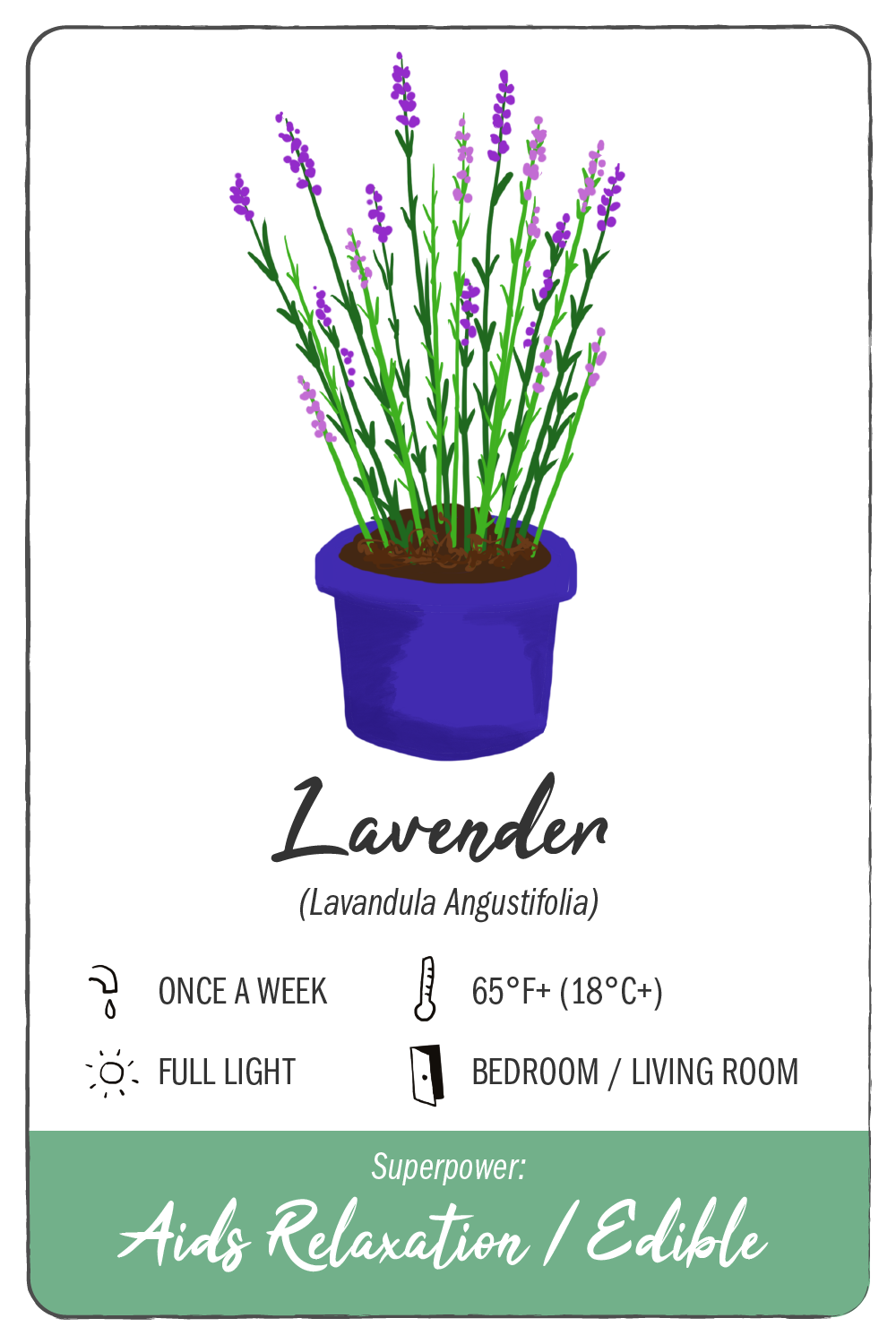
This pretty, sweet smelling delight is a herbalists dream. Originally from the Mediterranean (despite often being referred to as English Lavender), it’s a multipurpose plant that’s perfect for not only adding a splash of colour to your living space, but it can be a real help as a relaxation aid, too.
Placing a Lavender plant in your bedroom or living room is a great way to help you drift off to sleep or unwind at the end of the day, as the calming scent permeates throughout the room.
Not only is the scent of the Lavender plant helpful, but the plant itself has many uses too. The flowers can be used as a culinary herb in cooking or as a herbal tea and the oils that can be extracted can be used in massage therapy or added to things such as lotions, soap and bath oils. Basically, Lavender is probably one of the most chilled out plants you can find, so it makes sense to add one to your home!
As you’d probably expect, it’s pretty easy going when it comes to upkeep, too. It likes a sunny spot and doesn’t like to be over-watered – so a watering once a week to keep the soil moist (not wet) should be all you need to do to help it to help you.
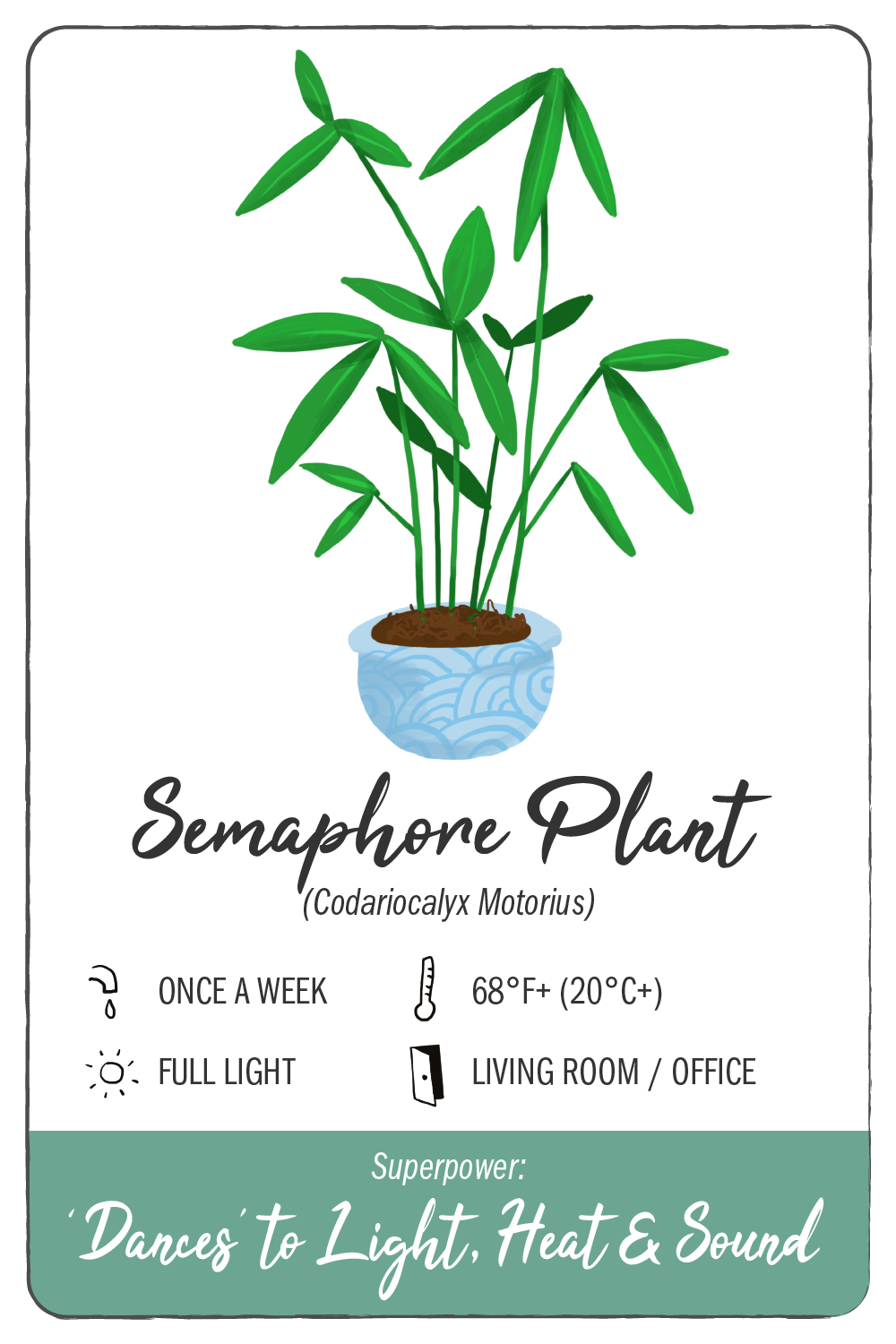
And last but by no means least, we have the Semaphore Plant (or Telegraph Plant as it’s also known). Another “interactive” plant with some super “dance” moves. The Semaphore is an ornamental plant native to tropical Asia that is capable of rapid movement, much like the Mimosa and Venus Flytrap.
When we say dance moves, it’s not strictly true but the Semaphore does have the ability to move its leaves at speeds rapid enough to be seen, particularly when subjected to light, heat or sound. Each leaf is equipped with a “hinge” that allows it to move to optimise the amount of sun it absorbs. The really clever part is that each large leaf comes with its own pair of smaller “worker” leaves that will constantly rotate to first sample the surroundings and guide the larger leaf to where it will thrive best. The reason for this is because the movement means the plant expends a lot of energy when the large leaf rotates, making it much more economical. Like the Mimosa, the Semaphore will also go to “sleep” at night and reawaken with the sunlight.
And while the light plays a big part in its day to day function, no one is quite sure why sound has the same effect. The small leaves will seemingly “dance” when exposed to varying pitches of sound. We’re not sure why the Semaphore has a penchant for music, but we love that it does!
In terms of care, the Semaphore does appreciate a warm, sunny spot, so it makes a wonderful talking point in any living room or office. They’re not particularly thirsty but remember the more regularly it “dances” the more water it will need, but as a basis should be watered once a week as a baseline.
Becoming a new plant parent really doesn’t need to be stressful, especially when there’s such an array of different and unusual plants out there to choose from. Our advice would be to do a bit of research on the houseplants you’d like to buy, make sure where you’d like to put it is suitable and then just go for it! Oh, and don’t forget to water it!
Now that you’re a houseplant aficionado, check out our range of internal doors to see the glazed options we have available, such as the Oak 4L Interior Door or the P10 Oak Frosted Door. This will make sure your potted pals get all the light they could need!
If you have any questions about any doors in our range, get in touch with a friendly member of our team today.

Specialist suppliers of high quality, internal and external folding and french doors. Buy direct for the best price.
Delivery to most mainland UK postcodes within 3-7 working days. Free delivery on orders over £750.
The Climadoor
Guarantee Promise
All of our doors and hardware are guaranteed for ten years against the occurrence of manufacturing faults.
0203 846 0345
Telephone: 0203 846 0345 Email:
[email protected] ©Climadoor Ltd 2021. All rights reserved.
Showroom: Unit 2 Sinfin Central Business Park, Sinfin Lane, Derby DE24 9HL. Buy online or via selected stockists: Vibrant
Doors / Express Doors Direct / Vivid
Doors
Terms & ConditionsRefunds & ReturnsOur Guarantee PromisePrivacy PolicyClimadoor Voucher Codes Sitemap

Please contact us for details regarding our FSC® certified products.
Choosing the perfect bifold door for your space can be challenging with so many options available. Our Roomfold Comparison table is here to simplify the process, providing a side-by-side breakdown of the key features, specifications, and benefits of our Roomfold Standard, Deluxe, and Grande systems. Whether you’re prioritising size, finishes, or hardware, this detailed comparison will help you find the ideal solution tailored to your needs.
| Roomfold Standard | Roomfold Deluxe | Roomfold Grande | |
|---|---|---|---|
| Size Width Options | 1215mm - 3502mm | 1218mm - 4652mm | 836mm - 3891mm |
| Available Finishes | Unfinished Oak, Prefinished Oak, & White Primed | Unfinished Oak, Prefinished Oak,& White Primed | Unfinished Oak, Prefinished Oak, White Primed, Black |
| Door Options | 3,4, and 5 door options. | 3,4,5 & 6 door options | 2,3,4 and 5 door options |
| Trimming Ability - Height | 20mm on height (contact us for details, as some sets can be trimmed more than this) | 20mm on height (contact us for details, as some sets can be trimmed more than this) | 20mm on height (contact us for details, as some sets can be trimmed more than this) |
| Trimming Ability - Width | 20mm on 2 doors and then an extra 10mm per door thereafter. Where individual door leaf sizes are 686mm or bigger the trim allowance is 20mm per leaf - equal amounts off each side of the door. | 20mm on 2 doors and then an extra 10mm per door thereafter. Where individual door leaf sizes are 686mm or bigger the trim allowance is 20mm per leaf - equal amounts off each side of the door. | 20mm on 2 doors and then an extra 10mm per door thereafter. Where individual door leaf sizes are 686mm or bigger the trim allowance is 20mm per leaf - equal amounts off each side of the door. |
| Frame Depth | 78mm | 78mm | 133mm |
| Frame Height | 2078mm | 2078mm | 2060mm |
| Hardware | Top Hung only, with floor mounted pivot. | Top Hung, bottom guided, with 20mm high low level guide rail. Ideal for running different floorings up to each side. | Top Hung, with jamb mounted bottom pivot. Ideal for fitting on top of existing floorings, where the flooring finish is the same both sides of the door set. Or ideal on top of tiled floors. |
| Hardware Adjustment | Height - 6mm | Height - 6mm | Height - 10mm |
| Supplied with Drop Bolts | No | Yes | Yes |
| Delivery / Collection | Delivery £60, Collection free from either DE24 9HL, or S44 5HS, after order. All orders over £750 are free delivery. | Delivery £60, Collection free from either DE24 9HL, or S44 5HS, after order. All orders over £750 are free delivery. | Delivery £60, Collection free from either DE24 9HL, or S44 5HS, after order. All orders over £750 are free delivery. |
| Guarantee | 10 years against manufacturing defects | 10 years against manufacturing defects | 10 years against manufacturing defects |
| Bespoke Service Available (24 week lead time) | No | No | Yes |
| Key Features and Benefits | Pairmaker not supplied on “meeting door” configurations. Frame always supplied in an unfinished Oak for on-site decorating no matter the door finish. Face fit hinges and hinge handle. Ideal for customers that will have the doors in their fully open or fully closed position 90% of the time and not using the mechanism on a regular basis. Perfect for closing off a room ona budget renovations/ offices. Will allow through flooring. | Frame supplied matching the door finish chosen. Can fill larger openings as the bottom track allows up to six door systems. Smooth operation at larger total widths with connection to the head and base track on the end of every other door. Face fit hinges and hinge handle. Ideal for customers changing flooring between rooms as the 20mm high 74mm deep low-level threshold gives a clean break between flooring. A robust, cost-effective system. | Frame supplied matching the door finish chosen. Superior “external grade” hardware allowing an incredibly smooth operation with no need for a base track. Face fit hinges and hinge handle including an offset hinge system which allows the doors to stack more compact than the other Roomfold options. Supplied with door stops across the whole internal rebate of the frame leaving no gaps at the top between top edge of the doors and underside of the track meaning they will offer more in terms of heat retention and sound reduction between rooms. More opening options that can suit any home. Our highest specification system with upgraded, stylish hardware. |
| Overall Rating |

